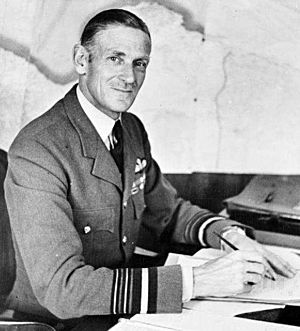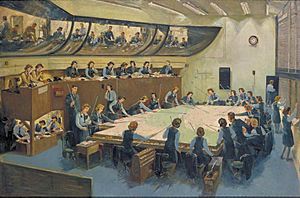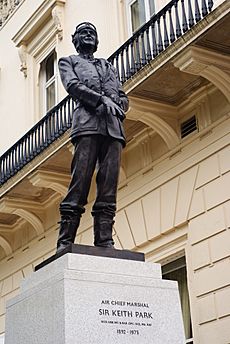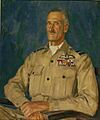Keith Park facts for kids
Quick facts for kids
Sir Keith Rodney Park
|
|
|---|---|
 |
|
| Nickname(s) | "The Defender of London" "Skipper" |
| Born | 15 June 1892 Thames, New Zealand |
| Died | 6 February 1975 (aged 82) Auckland, New Zealand |
| Allegiance | New Zealand (1911–15) United Kingdom (1915–46) |
| Service/ |
New Zealand Military Forces (1911–15) British Army (1915–18) Royal Air Force (1918–46) |
| Years of service | 1911–1946 |
| Rank | Air Chief Marshal |
| Commands held | Air Command, South East Asia (1945–46) Middle East Command (1944–45) AHQ Malta (1942–44) AHQ Egypt (1942) No. 23 (Training) Group (1940–42) No. 11 (Fighter) Group (1940) RAF Tangmere (1937–38) RAF Northolt (1931–32) No. 111 Squadron (1927–28) No. 48 Squadron (1918–19) |
| Battles/wars | First World War
Second World War |
| Awards | Knight Grand Cross of the Order of the Bath Knight Commander of the Order of the British Empire Military Cross & Bar Distinguished Flying Cross Croix de guerre (France) Commander of the Legion of Merit (United States) |
| Other work | City Councillor, New Zealand |
Air Chief Marshal Sir Keith Rodney Park (15 June 1892 – 6 February 1975) was a brave officer from New Zealand. He served in the Royal Air Force (RAF). During World War II, his amazing leadership helped defeat the German Luftwaffe in the Battle of Britain. He led No. 11 Group, which protected London and southeast England.
Born in Thames, Keith Park first worked as a sailor. He joined the New Zealand army for World War I. He fought in the Gallipoli campaign and the Battle of the Somme. After being wounded, he joined the Royal Flying Corps, which later became the RAF. He became a flying ace, meaning he shot down many enemy planes. He even commanded his own squadron.
Between the two World Wars, Park held many important roles in the RAF. By the late 1930s, he helped design air defence plans for the United Kingdom. When World War II began, he took charge of No. 11 Group. This group faced the main German air attacks during the Battle of Britain. Park's clever tactics helped Britain keep control of the skies.
After the Battle of Britain, Park moved to a training role. Later, he went to the Middle East. In 1942, he took over the air defence of Malta, which was under heavy attack. He turned Malta's air forces from defending to attacking. From 1944, he held senior roles in the Middle East and India. He retired from the RAF in 1946 as an Air Chief Marshal. He returned to New Zealand and worked in aviation and local government. He passed away in 1975.
Contents
Early Life and First World War Service
Growing Up in New Zealand
Keith Rodney Park was born in Thames, New Zealand, on 15 June 1892. He was the ninth child in his family. His father, James Park, was a geologist from Scotland. Keith went to King's College and then Otago Boys' High School. He joined the school's Cadet Corps, which was like a military training group.
After school, Keith worked for a shipping company. He loved boats and was even nicknamed "Skipper." He worked on steamships, sailing along the coast and to Australia. From 1911 to 1913, he also served as a soldier in the New Zealand Field Artillery.
Fighting in World War I
When World War I started, Park joined the New Zealand Expeditionary Force in December 1914. He became a corporal in the Field Artillery. In early 1915, he went to the Middle East.
Park fought in the Gallipoli campaign in April 1915. He was part of the landing at Anzac Cove. His artillery unit had little ammunition, so he often worked as a messenger. He was recognized for his bravery and became a second lieutenant in July. He then made an unusual choice: he transferred to the British Army.
On the Western Front
In January 1916, Park was sent to Egypt. Soon after, his unit moved to the Western Front in France. He became interested in aviation after seeing how useful planes were for spotting enemy positions.
On 21 October 1916, during the Battle of the Somme, Park was wounded by a German shell. He was sent to England to recover. This injury turned out to be lucky for his career. In December, he joined the Royal Flying Corps (RFC).
Becoming a Flying Ace
Flight Training and Instructor Role
Park began his RFC training in December 1916. He learned to fly different planes and quickly earned his pilot's wings. He was a good pilot, so he became an instructor in March 1917. This helped him gain a lot of flying experience.
In June 1917, Park was sent to France. He joined No. 48 Squadron, a fighter unit. They flew the new Bristol F.2 Fighter, a two-seat plane used for fighting and scouting.
Aerial Victories and Awards
Park had his first fight with German planes on 24 July 1917. He and his observer fought off three enemy aircraft. No. 48 Squadron also protected England from German bombers.
Park became a flying ace by shooting down many enemy planes. On 12 August, he scored his second victory. He and his observer, Arthur Noss, shot down an enemy plane. They continued to have success, destroying several more German aircraft. For their bravery, Park and Noss were awarded the Military Cross (MC).
Park continued to excel. By September, he was the squadron's most successful pilot. He was awarded a Bar to his MC, meaning he received the medal a second time. He also received the French Croix de guerre for his service. In January 1918, after a tough fight where his plane was damaged, he was sent back to England for rest.
Leading No. 48 Squadron
In March 1918, Park returned to France as a major to lead No. 48 Squadron. He was the only pilot left from their 1917 team. He was respected by his men, even though he kept a professional distance.
His squadron flew dangerous low-level attacks on German troops. They also did regular scouting missions. Park was wounded again in August during a bombing raid on his airfield. He still helped other injured men escape. The war ended on 11 November 1918. Park was credited with destroying 11 enemy aircraft and damaging 13 others.
Between the Wars
Joining the RAF and Staff Roles
After World War I, Park married Dorothy "Dol" Parish, a nurse. He joined the new Royal Air Force (RAF) in 1919. Despite some health concerns from his war wounds, he was given a permanent commission. He was awarded the Distinguished Flying Cross for his service.
Park held various roles, including commanding a training depot. In 1922, he attended the RAF Staff College. Here, he studied alongside future RAF leaders like Charles Portal.
Developing Air Defence
In 1926, Park joined the Air Defence of Great Britain (ADGB). He helped plan how to protect the United Kingdom from air attacks. He worked closely with Air Vice Marshal Hugh Dowding, who would become a key figure in the Battle of Britain.
Park later commanded No. 111 Squadron, a fighter unit. He made sure his pilots trained hard. He was promoted to wing commander in 1929. He continued to work on systems to control fighter aircraft. He also commanded the RAF station at Northolt and became a chief instructor at Oxford University Air Squadron.
Serving in South America
In 1934, Park became the Air Attaché in South America. This meant he represented the RAF and promoted British aircraft. He learned Spanish for this role. He traveled widely, visiting air bases and aircraft factories. This experience helped him learn how to quickly inspect air bases, a skill that would be useful later.
Fighter Command Leadership
In 1938, Park became the Senior Air Staff Officer (SASO) to Hugh Dowding, who led Fighter Command. Park was now second-in-command to Dowding. They worked together to create a new air defence system for the UK. This system used radio direction finding (radar) to track enemy planes. Park helped improve how data was used to guide fighter planes.
Park also wanted to change fighter tactics. He suggested using heavier machine guns on planes like the Hawker Hurricane and Supermarine Spitfire. He also disagreed with the standard "Vic" formation for fighters. However, his ideas were not adopted by the Air Ministry at that time.
World War II Heroics
Leading No. 11 Group
When World War II began, Park helped Dowding keep as many fighter planes as possible in the UK. This was important for defending against German attacks. On 20 April 1940, Park became the commander of No. 11 Group. This group was in charge of defending London and southeast England.
Park's appointment caused some tension with Air Vice Marshal Trafford Leigh-Mallory, who led the neighboring No. 12 Group. Park had more experience with fighter planes.
Dunkirk Evacuation
In May 1940, many British, French, and Belgian troops were trapped at Dunkirk. During the Dunkirk evacuation, No. 11 Group provided air cover. Park's fighters had to fly far from their bases, giving them limited time over Dunkirk.
Park decided to use stronger patrols with more squadrons, rather than continuous, weaker coverage. He even flew his own Hurricane over Dunkirk to see the situation for himself. He also visited airfields and met pilots and ground crew. He was easy to spot in his white flying overalls. This helped him connect with his team.
The Battle of Britain
The Battle of Britain began in July 1940. No. 11 Group faced the main German air attacks. Park had about 350 fighters and 550 pilots. He also got help from other fighter groups when needed.
Park's goal was to attack German bombers before they reached their targets. He tried to avoid fighting the German fighter escorts directly. He used plotting tables at his headquarters in Uxbridge to track incoming raids. He had to decide quickly which raids were real threats. He usually had only about 20 minutes from when radar detected German planes to get his squadrons into the air.
The Luftwaffe first attacked shipping and ports. Later, they targeted radar stations and airfields. This put a lot of pressure on Park. He had to manage his squadrons carefully. He also visited airfields often, which boosted morale, especially at bases that had been bombed.
On 16 August, Prime Minister Winston Churchill visited Park's headquarters. Churchill later made his famous speech about the RAF pilots: "Never in the field of human conflict has so much been owed by so many to so few."
On 15 September, the Luftwaffe launched its biggest daytime raid. Churchill was there again. Park calmly assured him that the RAF would meet the attack. All of Park's planes, plus 60 from No. 12 Group, went up. The German attack failed badly. This day became known as Battle of Britain Day. Hitler then postponed his planned invasion of England.
In September, the Germans switched to bombing London. This gave Park's airfields a chance to repair. Park later said that the Germans lost the Battle of Britain when they stopped bombing his fighter stations and started bombing London. He also changed his tactics to intercept German planes returning to France. He worked hard to keep his pilots rested and ready.
After the Battle of Britain
By late October, the Battle of Britain was over. On 7 December, Park was replaced as commander of No. 11 Group. He believed this was due to his disagreements with Leigh-Mallory. However, officially, it was said he needed rest. Many people praised Park's leadership. Arthur Tedder, a future RAF leader, said, "If ever any one man won the Battle of Britain, he did." Park was known as the "Defender of London."
Churchill was upset that Park and Dowding were not mentioned in an early RAF pamphlet about the Battle of Britain. This was later corrected.
Training Command and Malta
Park then took charge of No. 23 Group in Training Command. He quickly improved training procedures and modernized airfields. He continued to visit his units regularly.
In December 1941, Park was posted to Egypt as Air Officer Commanding. He was responsible for defending the Nile Delta, similar to his role in the Battle of Britain. He improved Egypt's air defences against German attacks.
On 14 July 1942, Park went to Malta to take over the RAF command there. Malta was under heavy attack from German and Italian forces. Park changed the defensive tactics. Instead of waiting for enemy bombers over Malta, he sent his Spitfires to intercept them earlier. He called this his Forward Interception Plan.
His new tactics worked quickly. Within a week, daylight raids stopped. Park's forces regained control of the skies over Malta. RAF bombers and torpedo planes returned to Malta. They began attacking Axis supply lines in North Africa. Park was made a Knight Commander of the Order of the British Empire for his service in the Middle East. His work was praised by American General Dwight D. Eisenhower and British General Bernard Montgomery.
In 1943, Malta became a major airbase for the Allied invasion of Sicily. Park directed operations from a new control room on Malta. He had 40 squadrons under his command.
Middle East and Far East
In January 1944, Park was promoted to air marshal. He became the air officer commander-in-chief of RAF Middle East Command. His duties included overseeing air operations in the eastern Mediterranean and Indian Ocean. He also trained RAF personnel in the region.
On 1 January 1945, Park was appointed a Knight Commander of the Order of the Bath (KCB). Soon after, he became the Allied Air Commander for South-East Asia Command (ACSEAC).
In this new role, Park ensured that General William Slim's 14th Army received air supplies as they advanced through Burma. He pushed for faster repairs of captured airfields. He also continued his practice of visiting RAF stations across his wide command area.
On 12 September, Park was present for the formal surrender of Japanese forces in Singapore. After the surrender, his main task was to bring home 125,000 Allied prisoners and civilians from prisons in Southeast Asia. He even used Japanese aircraft and personnel to help. He also worked to send British soldiers and airmen back to the UK.
Later Life and Legacy
Retirement and New Career
In late 1945, Park's headquarters moved to Singapore. Morale was low among RAF personnel due to slow repatriation. Park tried to address their concerns. In April 1946, he was the acting Supreme Allied Commander of South-East Asia, his highest command. The following month, he was appointed a Knight Grand Cross of The Most Honourable Order of the Bath (GCB) for his service.
Park retired from the RAF on 20 December 1946, with the rank of air chief marshal. He was also recognized by the United States with the Legion of Merit.
After retiring, Park became a representative for Hawker Siddley Group, an aircraft manufacturer. He sold military and civilian aircraft to countries in South America. He then became Hawker Siddley's Pacific representative in New Zealand.
Park also played a key role in establishing Auckland International Airport at Māngere. He chaired the International Airport Committee, working to get the land and support needed. The airport began international operations in 1966.
Personal Life and Public Recognition
In 1951, Park's son Ian, a police officer, was killed in British Malaya. This was a very sad time for Park and his wife.
In 1955, Park helped donate a Supermarine Spitfire to the Auckland War Memorial Museum. He personally selected the aircraft in the UK. The Spitfire is still on display at the museum.
Park retired from Hawker Siddley in 1960. He then became an Auckland City Councillor in 1962, serving three terms. He continued to be involved with the airport's construction.
A film about the Battle of Britain was released in 1969. Park found the film entertaining but noted some parts were fictionalized.
Death and Memorials
Park suffered several heart attacks in his later years. He passed away in Auckland on 6 February 1975, at age 82. He received a military funeral. His ashes were scattered over Waitemata Harbour from an aircraft. A memorial service was also held in London.
Sir Keith Park is remembered in New Zealand by the Sir Keith Park Memorial Airfield in Thames. The Museum of Transport and Technology in Auckland has a replica of the Hurricane he flew. A school in South Auckland is also named after him. In 2019, a bronze statue of Park was unveiled in Thames.
In the United Kingdom, a road near the former RAF Biggin Hill is named Keith Park Crescent. A train locomotive was also named after him. In 2009, a temporary statue of Park was placed in Trafalgar Square in London to honor his role in the Battle of Britain.
A permanent bronze statue of Sir Keith Park was unveiled in Waterloo Place in London on 15 September 2010. This was during the 70th anniversary of the Battle of Britain. Air Chief Marshal Stephen Dalton said that Park was "a man without whom the history of the Battle of Britain could have been disastrously different."
Images for kids










